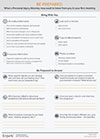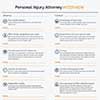
Who’s liable for a bike accident? What bike laws do you need to know?
One of the most successful marketing campaign slogans ever created is: “Virginia is for lovers.” But the slogan might have been even more accurate if it was: “Virginia is for bike lovers.”
According to the League of American Bicyclists, Virginia is the 9th most bike-friendly state in the country. The state ranks 3rd in the country when it comes to bicycle infrastructure and funding, and 4th when it comes to bicycle planning and evaluation.
Despite the high marks, bike accidents are relatively common in Virginia.
If you’ve been in a bike accident in the Old Dominion State, or if you’re simply an active biker, it’s important to understand the laws governing bikes and bike accidents.
Bicycle accident statistics
Virginia is one of the safest states for bicyclists. The only city in Virginia that even cracks the top 40 when it comes to cities with the most bicycle fatalities is Virginia Beach, Virginia, which has an annual bike-fatality rate of 4 per 1 million residents.
| Bicycle crashes in Virginia (2018) | ||
|---|---|---|
| Fatal crashes | Injury crashes | Property damage crashes |
| 13 | 591 | 29 |
|
Source: Virginia Highway Safety Office |
||
Though bicyclists sometimes make mistakes that cause them to crash, it’s just as likely that the crash was not their fault.
| Bicyclist actions leading to crashes in Virginia (2018) | |
|---|---|
| Action | Number of accidents |
| Improper lane change | 13 |
| Avoiding other vehicle | 3 |
| Avoiding pedestrian | 0 |
| Failure to yield | 113 |
| Following too closely | 7 |
| Hit and run | 5 |
| Illegal improper parking | 1 |
| Improper backing | 0 |
| Improper passing | 4 |
| Improper turn | 7 |
| Left of center-not passing | 25 |
| Lights not on | 15 |
| Ran traffic control | 41 |
| Speed too fast | 1 |
| Other | 79 |
| No improper action | 297 |
| Not provided/not applicable | 27 |
| Total | 638 |
|
Source: Virginia Highway Safety Office |
|
Virginia bike laws
Just like all other states in the country, Virginia requires bicyclists to follow the same rules and regulations as motor vehicles. For example, bicyclists are required to stop for traffic lights and stop signs.
Additionally, there are bike-specific laws that only impact cyclists. Most of these laws can be found in Title 46.2 of the Code of Virginia.
Let’s take a look at some of the most important laws that are most likely to impact you as a bicyclist.
Traffic controls
Bicyclists must obey all traffic signs, signals, lights, and markings (just like a motor vehicle). Failing to obey a traffic sign, signal, light, or marking is punishable by a fine of no more than #350.
Where to ride
Virginia law restricts how bicycles can navigate the roadways. Here are the highlights:
- Bicyclists must ride with the flow of traffic on the right side of the road
- Bicyclists operating their bike slower than the speed of traffic must ride as close to the side of the road as possible
- Bicyclists are NOT prohibited from riding on the highway shoulder (meaning it is allowed)
- Bicyclists are prohibited from riding between 2 lanes of traffic moving in the same direction (i.e., “lane splitting”)
- Bicyclists must ride single-file on roadways and not ride more than 2 abreast on highways
- Bicyclists are permitted to ride on sidewalks unless prohibited by local ordinance or signs (when doing so, bicyclists must yield the right of way to pedestrians)
Turning and signalling
Bicyclists must signal their intention to turn or stop. In addition to being the law, signaling your intentions greatly reduces the chances of being struck by a car.
- A right turn can be signaled by raising your left arm vertically or extending your right arm horizontally
- A left turn can be signaled by extending your left arm horizontally
- A stop can be signaled by lowering your left arm so that it’s pointing vertically at the road
Passing
Bicyclists are allowed to pass other vehicles on the right or left when it’s safe to do so.
If a motorist passes a bicyclist, they must maintain at least 3 feet of space between the vehicle and the bicyclist when doing so.
Dooring
A “dooring” is a crash in which a bicyclist is struck by a door (or swerves to avoid a door) that’s opened quickly by a motor vehicle occupant who failed to check if anyone was approaching before opening the door.
In Virginia, motor vehicle operators and passengers are prohibited from opening car doors unless it’s reasonably safe to do so.
Helmet use
There is no statewide law requiring bicyclists to wear helmets. With that being said, many jurisdictions have passed ordinances requiring people 14 years of age and younger to wear helmets whenever riding or being carried on a bicycle.
At this time, the following jurisdictions have such ordinances in place:
| Jurisdictions in Virginia with local bicycle helmet laws | ||
|---|---|---|
| Counties | Independent cities | Independent towns |
| Albemarle Amherst Arlington Clarke Fairfax Floyd Orange James City Prince William York |
Alexandria Buena Vista Charlottesville Fairfax Falls Church Hampton Harrisonburg Manassas Manassas Park Newport News Norfolk Petersburg Radford Roanoke Salem Virginia Beach Waynesboro Williamsburg |
Berryville Blacksburg Christiansburg Colonial Beach Culpeper Farmville Front Royal Gordonsville Kilmarnock Leesburg Luray Purcellville Quantico Vienna |
Required equipment
Every bike ridden between sunset and sunrise must have:
- At least 1 white headlamp with light visible at least 500 feet to the front
- A red reflector visible at least 600 feet to rear
- At least 1 red tail light visible from 500 feet to the rear (only required on roads with a posted speed limit of 35 miles per hour or greater)
Accident reporting
All motorists and bicyclists in Virginia must stop and provide their contact information when they’re involved in an accident involving:
- Death
- Injury
- Property damage
If the biker damages property and can’t locate the owner, the bicyclist must leave their information on the property and report the accident to the police within 24 hours.
Who’s liable for a bike accident in Virginia?
Most personal injury claims made by bicyclists are negligence claims against motor vehicle drivers. To prove negligence in Virginia, a bicyclist must show that:
- The driver owed the bicyclist a duty. All drivers owe all others on the road a duty to drive with a reasonable degree of care.
- The driver breached their duty. To prove this, the bicyclist will have to show that the driver failed to drive with a reasonable degree of care. For example, perhaps the driver was distracted, speeding, or driving under the influence of alcohol.
- The bicyclist was injured as a result of the driver’s breach. The bicyclist must show that the driver’s actions (such as texting, speeding, or driving under the influence) caused the accident. In other words, if it wasn’t for the driver’s actions, the accident wouldn’t have occurred and the bicyclist wouldn’t have been injured.
Of course, not all accidents are caused by drivers. Just like drivers, bicyclists owe all others on the road a duty to ride with a reasonable degree of care. If a cyclist violates this duty, then they can be found negligent.
Additionally, bicycle accidents may be caused by:
- Property owners. Under premises liability laws, property owners are required to take certain measures to ensure that their property is safe for visitors. If a bicyclist is injured by a dangerous condition that exists on someone’s property (such as an uncovered manhole on a road or a piece of barbed wire strung across a bike path), the bicyclist can sue the property owner (including the government) for negligence.
- Manufacturers. If a bicyclist is injured by a defective bicycle component (such as a defective helmet), the bicyclist can sue the manufacturer of the component if the defect caused or contributed to an injury. This type of lawsuit is called a product liability lawsuit.
Comparative fault law in Virginia
Sometimes, both the plaintiff and the defendant are partially at fault for a bike accident.
Virginia is one of the few states that follows the pure contributory negligence rule. Under this rule, if the plaintiff is the least bit responsible for the accident (even 1%), the plaintiff is prohibited from recovering any damages.
Let’s look at an example:
Billy is approaching the 3-way stop from the east. He’s texting and driving, so he doesn’t see the stop sign. As a result, Billy blows through the stop sign and crashes into Samantha.
Samantha sustains serious injuries and sues Billy for $500,000.
At trial, Billy proves that Samantha didn’t have a headlight on her bike as required by Virginia statute.
The jury finds Billy 90% at fault for texting and for failing to stop at the stop sign. The jury finds Samantha 10% at fault for riding without a headlight.
In this example, Samantha would be barred from recovering any damages under Virginia’s pure contributory negligence rule, even though Billy ran the stop sign and hit her. It might not seem fair, but it’s the law in Virginia.
Types of bike accident damages
When bicycles and cars collide, the bicyclist never wins. Depending on the nature of the accident, injuries can range from minor scrapes to death. Here are some common bike accident injuries:
- Traumatic brain injuries and other head injuries
- Spinal trauma
- Broken bones
- Scrapes and bruises
- Death
Virginia allows car accident victims to recover both economic and noneconomic damages. Economic damages refer to the loss of monetary resources. Noneconomic damages are those damages that aren’t easily quantifiable.
Here’s a breakdown:
| Damages available in a Virginia bicycle accident lawsuit | |
|---|---|
| Economic damages | Noneconomic damages |
| Property damage | Pain and suffering |
| Medical expenses | Emotional distress |
| Lost wages | Loss of consortium |
Statute of limitations for bike injury claims
A statute of limitations is a law that limits the amount of time a plaintiff has to file a lawsuit.
In Virginia, the statute of limitations for injuries stemming from a bicycle accident is 2 years.
This means that you have 2 years from the date of the accident (or in some situations the date that you realize you’ve been injured) to file a personal injury lawsuit.
How to prepare to meet with your bicycle accident lawyer
Most initial consultations with an attorney are free. Because of this (and because your time is valuable), it’s best to be prepared for your first meeting.

A worksheet to prepare for your first meeting with a personal injury attorney – what to bring, what they'll ask
Download in PDF format

Worksheet with questions to ask a personal injury attorney to help determine if he or she will be a good fit for your case
Download in PDF format
See our guide Choosing a personal injury attorney.

